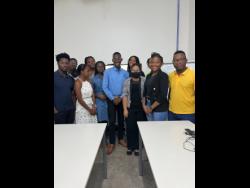
In a time where effective communication is more crucial than ever, mastering the art of public speaking becomes a powerful asset. Whether navigating boardrooms, engaging with clients, or simply expressing ideas, the ability to articulate thoughts with confidence is a game-changer. Shamar Wedderburn, managing director at Equipped to Speak, is all for championing the importance of soft skill development in our professional lives, particularly through Equipped to Speak’s signature presentation skills workshop, ‘Building Confident YOU,’ which took place on Saturday at CoWork JA in Kingston.
“The name of the workshop is meant to highlight the continuous building and subsequent confident boost that comes with going after everything that youth and young professionals have ever thought were beyond them. I wanted participants to come to the workshop with an open mind, imagining themselves standing tall in front of a crowd, and then delivering boldly instead of being comfortable with themselves in the background, ” said Wedderburn.
As a means to empower individuals and enhance their success, Wedderburn explored five tips to thrive in public speaking.
First, storytelling, Wedderburn says, is a timeless art. People remember stories better than facts or data alone. Learning to wove information into a narrative not only informs, but captivates your audience. From the corridors of business to the stages of public discourse, a compelling story can effectively illustrate complex ideas or concepts.
Embrace Authenticity
Second, in a world saturated with information, authenticity stands out and can be your greatest asset. There is power in being genuine in your communication. Learning to be effective within your own unique voice and your personality allows you to connect on greater levels while making you feel more relaxed as you retain your spontaneity.
Next, pay attention to non-verbal communication. Words only tell part of the story; body language and facial expressions convey the rest. So, delve more into the nuances of non-verbal communication such as varying your body movement depending on your audience’s responsiveness. Wedderburn also believes subtle cues such as a confident handshake to maintaining eye contact can speak volumes.
Connecting with your Audience
The fourth tip involves effectively engaging your audiences. According to Wedderburn, a key strategy for achieving this is to involve the audience right from the beginning. This can be as simple as encouraging them to introduce themselves to their neighbours or incorporating breaks into the presentation to pose questions. The essential message here is that individuals prefer interactive communication- speaking with them rather than at them. By establishing a connection, you create an environment that fosters openness to receiving the information you aim to convey.
Spend Extra Time on Planning and Preparation
Finally, he shared that perhaps the ultimate make or break for your next upcoming speech is likely to be the preparation. Wedderburn shared that in his experience, a significant 90 per cent of presentations hinge on thorough planning. This meticulous preparation provides a solid foundation, ensuring that your message is tailored to your audience. Doing this means considering what language, examples or stories will relate to your audience’s experiences, as well as whether the content of your speech aligns with intended end-purpose or goal.
